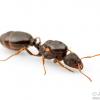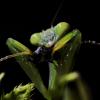I have 4 Camponotus castaneus queen, and 2 of them have workers. All of the others workers have died, and through experimentation, I have found out that you can move the queens together, as long as you dip them in water to remove their pheromones. I did that with on of my queens, and she is currently doing just fine with her new colony. I have had that queen for several months now. What I am going to however is merge all of them together with my biggest colony which is home to 11 workers. I will test out one worker just to be safe, but I have a feeling this will work. I will update you guys on the progress.
- Formiculture.com
- Forums
- Gallery
- Members
- Member Map
- Chat

























